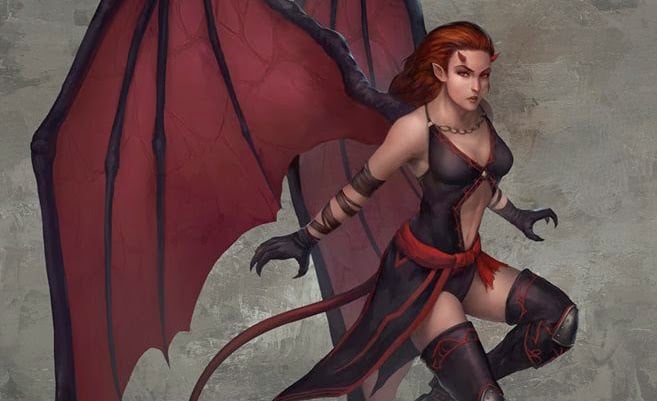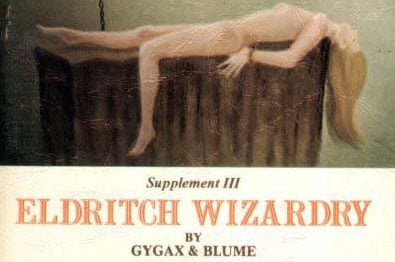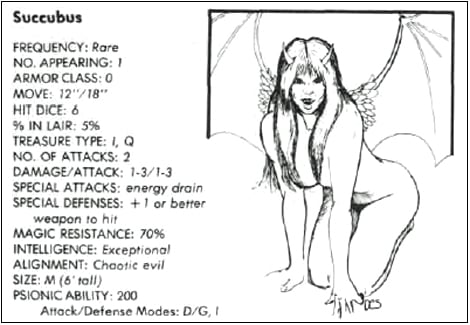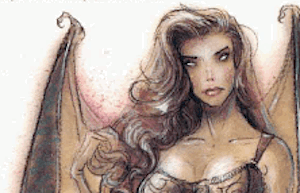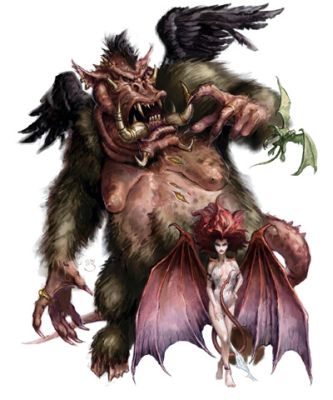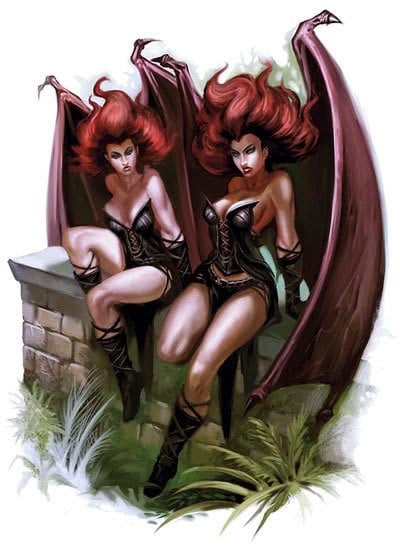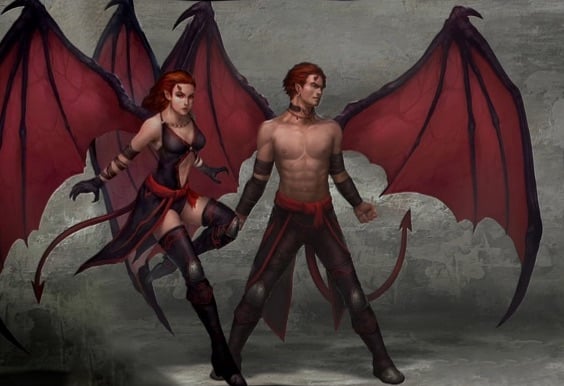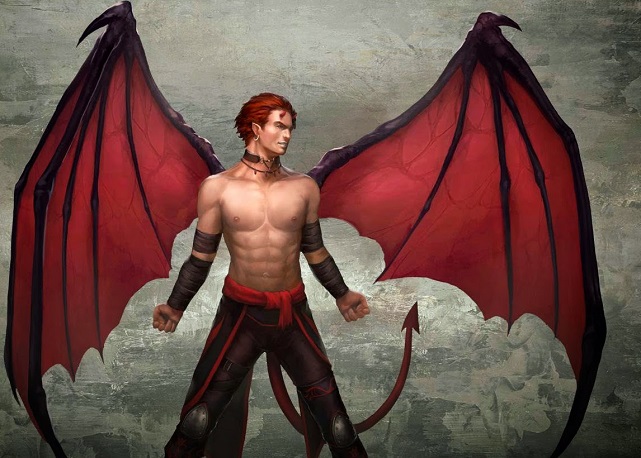RPG Monster Spotlight: Succubus & Incubus
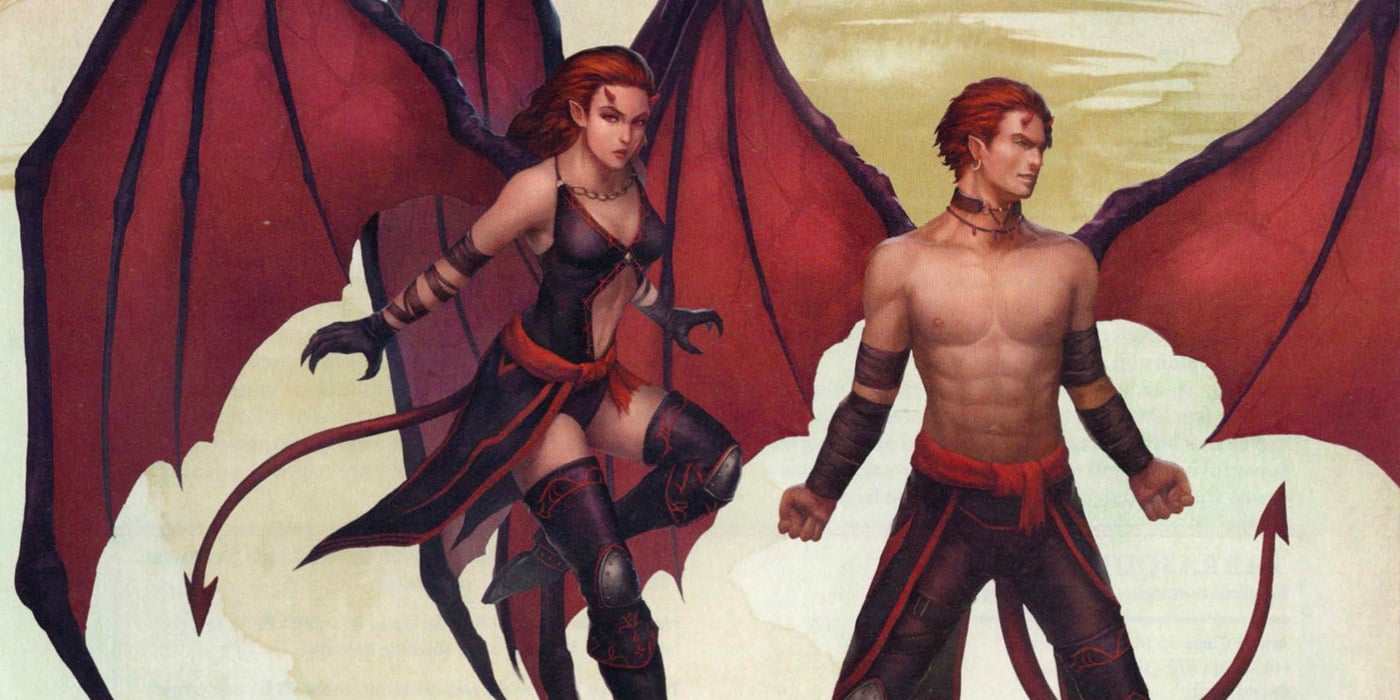

This week’s monster is the Succubus and her partner in seduction, the Incubus, who both know… all you need is love (bum ba da da dum).
Or if you can’t buy love, then any old four letter word that starts with L will do. We’re partial to Loop ourselves here at BoLS HQ. But there must be something in the air tonight because not only is Phil Collins playing, but we’re inexplicably drawn towards the latest monster to step into the spotlight: the Succubus. So let’s talk about Love and Other Demons.
The Succubus and Incubus have long been a part of D&D history, making their first appearance in the Eldritch Wizardry supplement, the third one ever for Dungeons and Dragons. Drawing on the real-world mythology where the succubi originate, their appearance in Dungeons and Dragons is an interpretation of the same iconic idea. Succubi and Incubi are demons of seduction. They’re representatives of that temptation of evil–specifically with regards to love, lust, and other things.
When they first appeared in Eldrtich Wizardry, they were very capable of achieving their aim of winning the hearts and minds of mortals, using their beautiful appearance, energy draining kiss, charm person, and suggestion to get whatever they needed from their victims.
And indeed, even as they transitioned from Eldritch Wizardry into the Monster Manual, 1st Edition Succubus were very much built around the idea of the mind/heart controlling monster that is capable of fighting more cleverly than with brute force. Though no slouch in combat, owing to their Armor Class of 0, their ability to fly, Exceptional intelligence, and immunity to any normal weapons.
But succubi and incubi are notorious for playing hard to get–which is reflected in their escape abilities. With the ability to cast darkness within a 5′ radius and to become Etheral at will, as well as being able to gate in a Nalfeshnee fairly reliably (or in desperate situations, calling even upon a Balor or a Demon Lord/Prince), it could be very hard to trap a succubus. Even in first edition, they were excellent masterminds–the sort who might hold a local baron in thrall and that a party of adventurers might have to face multiple times before finally driving them back to the abyss from whence they came.
Second edition introduced the Incubi officially to Dungeons and Dragons. Succubi and Incubi had their roles in the cosmos expanded–as did most demons and devils–with the advent of Planescape. Classified as Tanar’ri, and embroiled in a bitter unending Blood War, Succubi seem to be independent of most of the rest of tanar’ri society. They do what they want, and answer to no one. The greater demons tolerate this though, mostly because their actions tend to increase the power of the abyss, which is how the succubi contribute to the fight.
The edition change also made them deadlier–they gained immunity to even +1 magical weapons, fire attacks, and could never be surprised. Much more of a mastermind type villain. Especially since their energy draining kiss is now disguised by their demonic energies, requiring a Wisdom check at -4 penalty to notice each instance of level drain–otherwise the heat of the moment prevents a victim from noticing that they are being so effected.
2nd Edition Succubi/Incubi retain their spell like abilities from before, but also gain the ability to plane shift and transform from their demonic form into a normal humanoid one in order to disguise themselves and prey better on mortals. They also have a much more direct line to Balors–they went from a 25% chance to gate one in, to a 40% chance, though they do lose their connection to other demons.
The jump to 3rd Edition brought with it a whole host of changes for Succubi/Incubi. 3.x solidified the idea of monsters existing as a class of creatures, and all of them having the same sort of native abilities. Succubi are classified as Outsiders (and tanar’ri no less). But that means they gained damage reduction, darkvision, and their immunity to fire changed, making them immune to electricity and poison (as were most demons) as well as resistant to fire, acid, cold, and magic in general.
And in 3.x the Succubus’s energy drain became far more devastating, carrying with it a free suggestion of “hey keep kissing me so I can drain your energy” which had a fairly difficult (DC 21) Will save otherwise the victim would continue to receive negative levels.
This often meant doing a lot of math, especially if they targeted an unlucky spellcaster with their drain. Their abilities increased in overall power, though remained centered around this core idea of tempting creatures and ruling from the shadows. In 3.x succubi are highly skilled–employing diguise and intimidate and bluff to accomplish their goals through nonmagical means when necessary.
4th Edition Succubus and Incubus had massive changes. The Blood War must have been thrown into chaos, for Succubi/Incubi were reclassified as devils! Now, considering that succubi are all about temptation, and devils in particular in 4th edition were the “we will trick you into bargains and claim your soul forever” faction of the underworld, as opposed to the ravenous destruction of the demons, the reasoning behind this is clear.
Their function underwent a massive change as well. They changed from manipulator to a basically mind control machine. In a fight, their role was to dominate opponents. They had two main at-will attacks, a charming kiss which was basically an attack that had to hit both AC and Will defenses, and if it did it would render the succubi’s victim unable to target the demondevil–even going as far as to interpose itself between attacks that target the succubus until the demondevil or one of its allies attacked the target.
This, coupled with a ranged dominate attack could make for a difficult fight–but it could also mean a frustrating one. The biggest lesson I learned from 4th Edition was that players hate having their actions taken from them. Nothing is quite as frustrating as stunning attacks, which can basically lock out an unfortunate player from a fight altogether, but domination effects could be just as bad–thankfully the dominated condition had some errata applied to it later–but even so it could still feel frustrating. Plus in 4th Edition these demonsdevils lost much of their flavor and skills–they were pretty much there to mind control enemies.
5th Edition Succubi/Incubi have a little more freedom–they’re now just fiends that inhabit the Lower Planes. Neither demon nor devil natively, they serve all kinds of creatures. Devils, demons, night hags, rakshasas, yugoloths, even the Archdevils and Demon Lords are known to have them.
Additionally a succubus or incubus isn’t bound to a single “true” form, they can freely adopt whatever form suits them (succubi or incubi), though they do tend to have a preference for one form or another. They return to their role as the beautiful corruptors and tempters of the cosmos. But what I really enjoy about this edition is the sort of mythic feel they have.
For instance, they can claim the soul of a mortal by causing the victim to commit the three betrayals of thought, word, and deed–which resorts in it coming into possession of that mortal’s soul. Souls, of course, are a form of power in the Lower Planes, and this can make particularly clever succubi/incubi powerful players in those realms. They are also the source of Cambions–a fiendish offspring that comes about when a succubi or incubi mates with a humanoid.
But as far as their powers and stats go–they’re actually a bit less powerful in previous editions. The real strength of a succubi in this edition comes not from its combat capabilities–but rather from their cunning. It takes a DM willing to play up their deception and magical disguise–but that said, they can still present a formidable challenge for lower level characters. They are resistant to the most common energy types (fire, lightning, cold, poison), as well as nonmagical weapons. Their charm powers last for an entire day, and they can kiss charmed or willing targets dealing some fairly substantial psychic damage while also reducing their hit points.
I love this mechanic–it pays off for playing the longer game–a succubi/incubi that has the chance to reduce a character’s hit point maximum even two or three times can alter the tenor of a later climactic battle.
Well that’s the succubi–at the end of this article, we all feel curiously drained, but now that you know about these creatures, perhaps you can find a use for them in your campaigns. I particularly like the challenge of making lower level monsters matter more in high level campaigns, which has never been more possible than in 5th Edition.
So whether you’re tempted by succubi or incubi, happy adventuring and valentine’s day.

